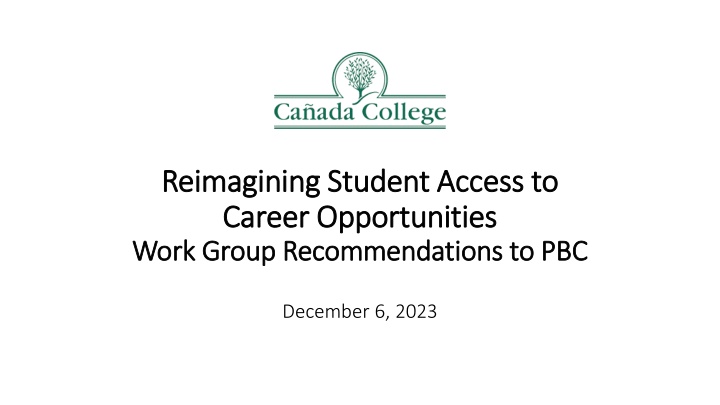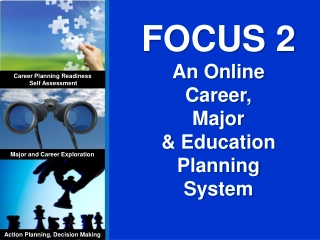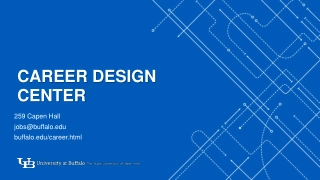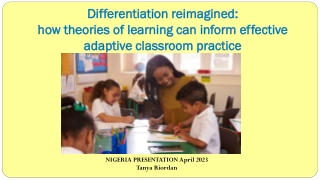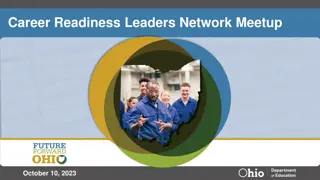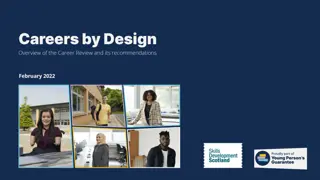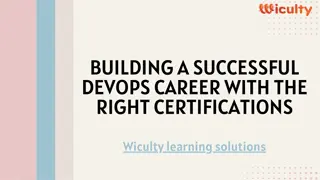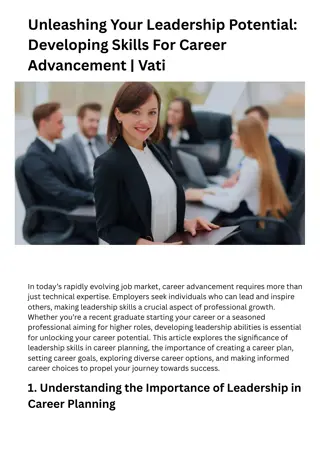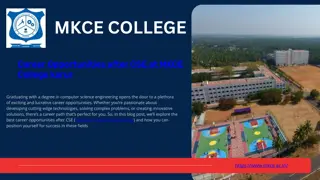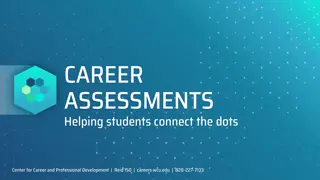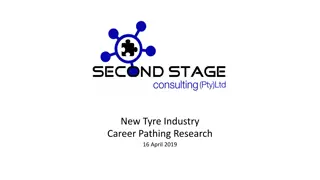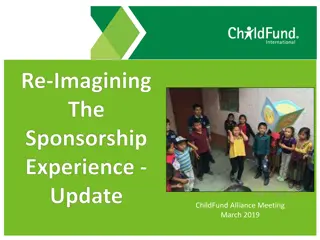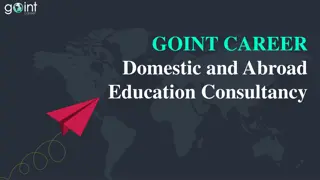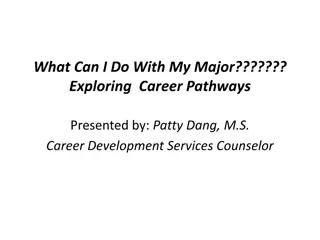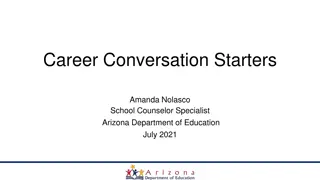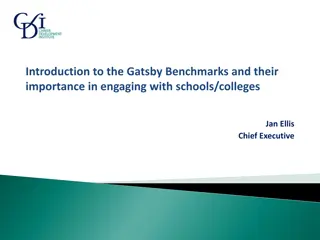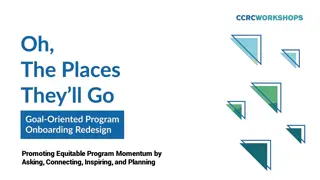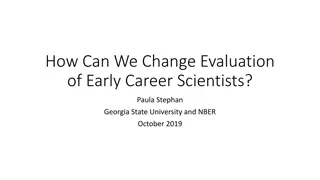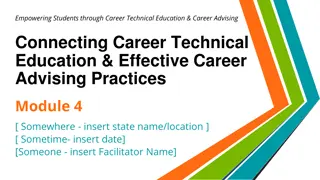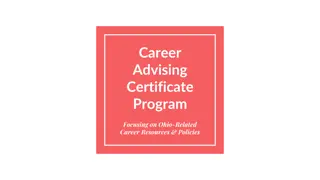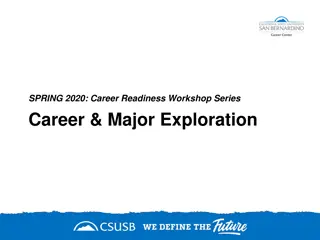Reimagining Student Access to Reimagining Student Access to Career Opportunities Career Opportunities
This document outlines the recommendations of a work group tasked with reimagining how students access career opportunities. Led by Dr. Karen Engel, the group aims to enhance services for students, align relationships with employers, and improve overall access to career pathways. Through defined processes and a focus on student outcomes, the group seeks to create a more supportive and effective system for students navigating career opportunities.
Download Presentation

Please find below an Image/Link to download the presentation.
The content on the website is provided AS IS for your information and personal use only. It may not be sold, licensed, or shared on other websites without obtaining consent from the author.If you encounter any issues during the download, it is possible that the publisher has removed the file from their server.
You are allowed to download the files provided on this website for personal or commercial use, subject to the condition that they are used lawfully. All files are the property of their respective owners.
The content on the website is provided AS IS for your information and personal use only. It may not be sold, licensed, or shared on other websites without obtaining consent from the author.
E N D
Presentation Transcript
Reimagining Student Access to Reimagining Student Access to Career Opportunities Career Opportunities Work Group Recommendations to PBC Work Group Recommendations to PBC December 6, 2023
Work Group Participants Karen Engel Hyla Lacefield Carole Meagher Max Hartman David Gainey Bob Haick Christopher Wardell Dean of Planning, Research, Innovation & Effectiveness Dean of Business, Design & Workforce Interim Workforce Development Director Dean of Counseling Project Director of Apprenticeships Program Supervisor (Career Center) Program Services Coordinator, Financial Aid Alyssa Lucchini Mercedes White Ron Andrade Rance Bobo Alex Jones Stephen Redmond Career Center (and Welcome Center) Program Services Coordinator - Menlo Park Guided Pathways Director Program Services Coordinator, STEM Center Adjunct Faculty - Cooperative Education Executive Director Middle College
Priority #4: Reimagine how we support students accessing career opportunities Who will do what on Priority #4? Work Group Lead: Dr. Karen Engel Desired Outcomes: Recommend to PBC on how we can better serve our students (organizational changes, programmatic changes, communication). Consider the bigger picture and make recommendations for aligning our relationships with employers to improve and scale career opportunities for students. Timing: Report recommendations to PBC before the end of the Fall 2023 term. 3
What does it mean to reimagine something? Different outcomes for students
Work Group Process Defined terms Gathered information about our of current employer engagement practices (and data management) Identified all Career On-Ramp programs on campus Shaped a Vision: If the College is successful in providing career opportunities for students, what does it look like? Conducted a focus group with 7 students to hear their perspectives Refined our Vision Finalized our recommendations
Career On-Ramp Constellation of Services Helping students jump-start career exploration
What does it look like if its working? The Director of Workforce Development, in close collaboration with the Career Center, ensures all programs that are part of the career on- ramp constellation of services at the College work together to: share information and data tools leverage employer relationships to scale opportunities for students leverage and optimize the college job board: College Central coordinate their calendars and services communicate in a cohesive way engage community partners and members (including those who are members of our Community Fitness program) to provide opportunities for students
What does it look like if its working? Students are supported in developing their portfolio of work readiness a LinkedIn Profile (linked with Ca ada College so they can remain part of our alumni network); a resume; at least one mock interview and elevator pitch practice in conducting themselves professionally (soft skills), and; digital copies of any work products or evidence of capstone projects or other learning outcomes of interest to potential employers.
What does it look like if its working? Students have experienced several forms of work-based learning (career on-ramps) Speakers who are knowledgeable about working in the field(s) in which students have interest Informational interviews Employer site visits/industry tours Field-based research experience Service learning and/or volunteer opportunities Job shadows Internships (paid and unpaid) Summer jobs (paid and unpaid) Paid on-campus work related to their field of study (perhaps via the Learning Aligned Employment Program (LAEP)) Cooperative Education (Co-op Ed) Pre-apprenticeship and apprenticeship Job placement assistance (Career Fairs as well as other opportunities to connect to employers and apply for employment)
What does it look like if its working? Career exploration is a seamless experience for students from undecided inquiry through meeting with experts in their chosen field and employment: a collective pipeline of career consciousness Communication about career on-ramps, work, and work- based learning opportunities is clear, consistent, part of our mainstream college experience via our: Outreach and Recruitment Ambassadors Website Catalog Interest Area Canvas Shells Career Center Canvas Shell LinkedIn Pro helps build our alumni network and communicate with students Print materials Event calendar Dual enrollment program Employer partners (Chambers, Business and Industry Associations) The college culture shifts so that everyone is aware of the opportunities listed above (career on-ramps) and helps students connect to them. Such that:
What does it look like if its working? Interest Areas are the focal point for career exploration and work-based learning Career On-Ramp programs are present in each Interest Area OR Each Interest Area is utilizing all of the career on-ramp opportunities and communicating effectively with faculty and students and monitoring student participation in career exploration activities.
What does it look like if its working? Academic Counselors refer students to career exploration opportunities in a way that helps inform their education goals Career On-Ramp staff and programs (Career Persons) meet with the Counseling Division regularly to provide up-to-date information about career exploration opportunities, educational pathways, and talking points
What does it look like if its working? Our not-for-credit students have access to all the same career on-ramp services as well as more support to transition to credit programs Menlo Park program students are better connected to the main campus and services. Our not-for-credit programs transition to non-credit to ensure student access to District services. Our not-for-credit pre-apprenticeship and other programs transition to a for-credit program. Not-for-credit program completers transition directly to employment.
What does it look like if its working? Career pathway programs start in high school, adult school, and in partner programs Career awareness and knowledge of on-ramps starts in High School, starting with dual enrollment and summer on-campus opportunities to explore pathways and careers. Adult School students have seamless access to career pathway programs at SMCCCD. The College works well with our WIOA partners (NOVA Works) to support job seekers, including youth and those with significant barriers to employment, access education, employment and training, and support services to succeed in the labor market.
What does it look like if its working? The College Alumni Network is strong and transparent in LinkedIn All completers and graduates join the network before they leave. College career on-ramp programs are able to tap the network to provide all of the work and work-based learning opportunities listed above.
Recommendations Ensure the Director of Workforce Development, in close collaboration with the Career Center, is able to enact the Vision above. Align and coordinate all of the Career On-Ramp programs and services at the College more formally. Ensure that college career on-ramp services are accessible, comprehensive, and coordinated and there is a nexus of information sharing. Develop database tools to facilitate information sharing and employer relationship management between College s Career On-Ramp programs and services. Develop non-credit CTE programs and pathways as a way to provide better college services to our not-for-credit students. Inform the College s efforts with the Governor s August 31st Career Education Executive Order
